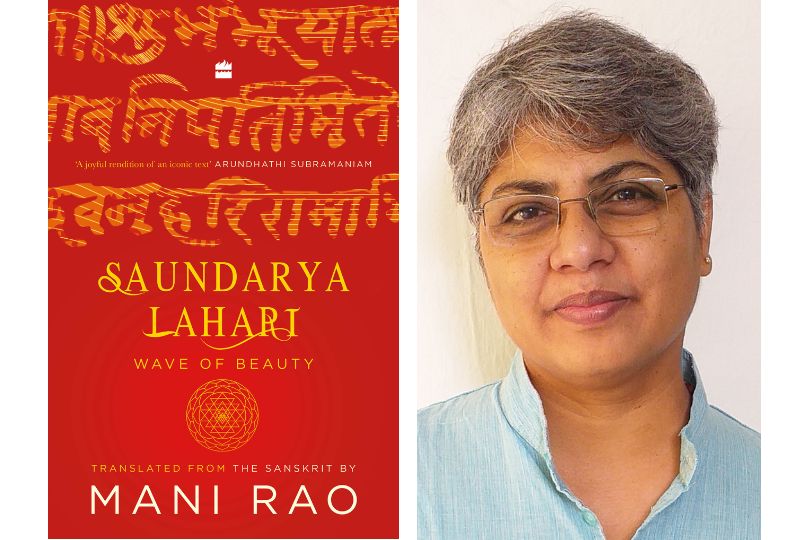Interview with Mani Rao, Author Of "Saundarya Lahari: Wave of Beauty"
on Oct 14, 2022

Mani Rao is the author of ten poetry books including Sing to Me, New & Selected Poems, Ghostmasters and Echolocation. Her books in translation from Sanskrit include Bhagavad Gita and Kalidasa for the 21st Century Reader. She did immersive fieldwork among tantric communities in Andhra–Telangana for Living Mantra: Mantra, Deity, and Visionary Experience Today. Mani has an MFA in Creative Writing and a Ph.D. in Religious Studies.
Frontlist: What is the meaning of Saundarya Lahari, and why did you select Saundarya Lahari to compile a collection of poems
Mani: Saundarya Lahari means a flood of – or a tidal wave of - beauty. It is a hymn in praise of Shakti, the primordial goddess.
I chose Saundarya Lahari because it insists on the absolute power of Shakti.
The idea of the Mother Goddess is widely prevalent in Indian traditions – don’t we see high emotions during the Navaratri festival !– this book joins that same devotional outpouring.
Saundarya Lahari is very popular, especially in South India – memorized and chanted – and has been sung by the who’s who of Carnatic music. But, manuals of Saundarya Lahari tend to come with complex commentaries and details of rituals, so the meaning of the verses and the poetic delights have not had ample exposure.
There are more than thirty-five commentaries on Saundarya Lahari – this immediately tells us of its importance in the history of Indian thought.
Finally, the world is a creative and challenging space. We need to harness our own inner shakti better. Contemplating the divine source, Shakti, helps - it is a vibrant and energizing experience.
Frontlist: How did you grow your penchant for learning mantras?
Mani: By experience. When you internalize a mantra, it transforms you. Mantras are said to be naturally occurring sound forms – perfect sound forms. They are bridges between our ideas and their manifestation. They are a great way to quieten the monkey's mind and open the door to higher pursuits.
Frontlist: Do you believe people can learn the fundamentals of Tantric Traditions via this book?
Mani: No. Tantric initiation is done by a guru. This book will not teach anyone tantra worship. It is only a way to know something about the meaning of the words of Saundarya Lahari. It is a book for the general reader.
But yes, people can read here about the Srichakra (the inverted triangles that tantric sources declare as a blueprint for the cosmos). One verse encodes the Srividya (the 15-syllabic mantra), considered the core of Shakta tantrism. Some verses describe the rising path of the Kundalini through the chakras in the body of Devi.
Saundarya Lahari is actually a complex and coded tantric text – commentators have noted other mantras coded within it.
Frontlist: What constitutes Tantric worship, and how does it vary from other religious practices?
Mani: Typically, it involves initiation by a guru. Tantric worship involves a deity and devotee and may include mantras, yantras (aniconic forms of deities and mantras), and ritual procedures. The objective is to cultivate bhava (emotional feeling), and aspire for oneness and identification with the divine. Ethics and discipline are of paramount importance.
Frontlist: The book is classified into two parts – Ananda Lahari: Wave of Bliss, and Saundaraya Lahari: Wave of Beauty. How are these components interconnected with each other?
Mani: In the first part, Shakti’s power is described, as well as a description of Shiva and Shakti together. While the entire hymn is called Saundarya Lahari, the second part (verses 42-91) is a eulogy of the beauty of the form of the goddess and describes her from head to toe. Verses 92-99 are more prayerful.
There are legends about who composed the two parts, arguments about whether Adi Shankara composed both parts, and so on.
Frontlist: What lessons can readers draw from mentioned poems as it represents Indian Mythology in a broader sense?
Mani: Fundamental learning in tantra is that our body is an instrument and that the divine is embodied in the material world. But – this means - not just that you are divine, but that everyone else is also divine J so one has to expand one’s love well beyond oneself. We cultivate a yearning for the divine and for the inner bliss described in the hymn (instead of being content with small pleasures).
Frontlist: Kindly share your favorite verse from all of them.
Mani: My favorite verse is no.27 in my book, the shloka which begins “japojalpaḥ”
Let my chatter be
the repetition of your name
mantra Japa
Let my activity enact
mystic signs
mudra
Let walking be the steps
of circumambulation
pradakṣiṇa
Let all food be
offerings to the sacred fire
āhuti
May laying down be
a prostration to you
praṇām
Let all pleasures that
give me comfort be
like an offering of
my own self
ātmārpaṇa
May whatever I enjoy be yours
like recurring prayers
Frontlist: What attributes does Shakti possess that we couldn’t find in any other deity, and what can we learn from them?
The hymn clearly spells out that Shakti is in a different category altogether. The world ends and begins with the closing and opening of her eyes. Even a speck of “dust” from her feet proves weighty for the gods. But -- Shakti is addressed often as “mother” – she is the generative power, the source, full of compassion and love.
Shakti teaches us to harness our own inner shakti and manifest ourselves better.



.jpg)






.jpg)

.jpg)
.jpg)
.jpg)

.jpg)
.jpg)

.jpg)








Sorry! No comment found for this post.